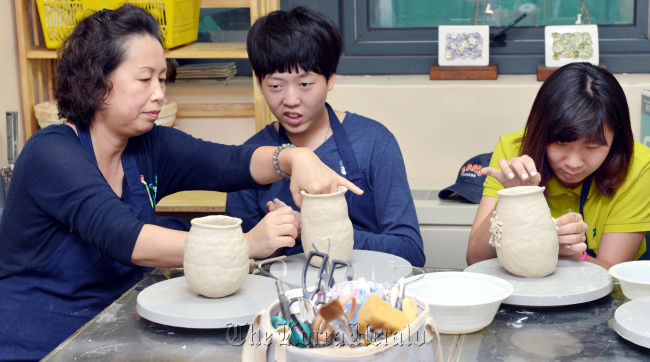Former hagwon boss helps mentally disabled open up through sculpture classes
In a small classroom, students start rolling and kneading clay after listening to the teacher’s instructions.
Showered with praise and encouragement from their teacher, they become engrossed in shaping stems and petals to make flowers.
Kim Jeong-min, 53, received a local welfare award from Seoul City for running a pottery class at Down Center for mentally disabled youth, which helps them gain psychological and emotional stability. Kim has been running a weekly class for over two years since 2010.
Established in 2003 and located in northeastern Seoul, Down Center provides welfare, education, rehabilitation, and various sports and culture activities for people with Down’s syndrome, autism and other cognitive disabilities.
Prior to working there, however, Kim’s life was far from philanthropic.
Since high school graduation, Kim worked at Daewoo Shipbuilding and Marine Engineering, majored in computer science at a community college, and ran an art institution for four years.
In a small classroom, students start rolling and kneading clay after listening to the teacher’s instructions.
Showered with praise and encouragement from their teacher, they become engrossed in shaping stems and petals to make flowers.
Kim Jeong-min, 53, received a local welfare award from Seoul City for running a pottery class at Down Center for mentally disabled youth, which helps them gain psychological and emotional stability. Kim has been running a weekly class for over two years since 2010.
Established in 2003 and located in northeastern Seoul, Down Center provides welfare, education, rehabilitation, and various sports and culture activities for people with Down’s syndrome, autism and other cognitive disabilities.
Prior to working there, however, Kim’s life was far from philanthropic.
Since high school graduation, Kim worked at Daewoo Shipbuilding and Marine Engineering, majored in computer science at a community college, and ran an art institution for four years.

After getting married, she followed her husband to the United States for his studies, where she tutored Korean students there in art and pottery. When she returned to Korea, she ran an English institution for four years.
“I lived such a hectic life,” she said.
While she earned a lot of money running private institutions, she said she barely had any time and felt that her life had become impoverished.
“I was so tired of it all that I decided I would do whatever I wanted when I hit my fifties.”
Kim was interested in art since childhood, and while she did not initially pursue art due to cost, she had been keeping her passion alive by studying under artist Seo Bong-nam for a year after community college, and majoring in ceramics in Kyung Hee University while supporting her husband’s studies in the United States.
She quit the English institution and took up pottery again at the School of Lifelong Education at Seoul National University of Science and Technology, exhibiting her works nearly every year since then.
Kim began working at Down Center when a colleague suggested she teach a pottery class there.
“I heard that students who work with clay start to open up to others, and that it stimulates their brain through sense of touch, which helps them.”
Kim currently teaches four students and two of their helpers, though her initial class started with eight more, who had since graduated Down Center’s Irum University.
The class works on a new piece each week, such as pottery, accessories and figures of plants and animals. She said that students usually take about six months before they become used to handling clay and start making actual works of art.
Kim said although it was difficult at first, her students started to open up more as they continued the class.
“The students don’t really express themselves, but they show great attachment to their work. I’ll never forget the looks on their faces when I lay out their work all in a row.”
Kim’s students present their work at Down Center every three months, and sell their items to visitors and parents every October.
They have also presented their work to various exhibitions. A piece her students made in 2010 called “In Search of Lost Time” won a special award in the a ceramics contest for disabled people and first prize at the exhibit hosted by the National Assembly in December 2010.
Kim said that she found happiness teaching pottery to her students.
“I feel like my horizons have expanded while working here. I start to see other people, not just myself, and feel grateful for what I have.”
In the future, Kim wants to provide lectures and free art classes in retirement complexes and welfare centers for the disabled while continuing to work as an artist.
“Even though I’m the one teaching them, I receive so much from them in return. I would like to find balance in my life by continuing to do what I enjoy.”
By Sang Youn-joo (sangyj@heraldcorp.com)
-
Articles by Korea Herald







![[KH Explains] How should Korea adjust its trade defenses against Chinese EVs?](http://res.heraldm.com/phpwas/restmb_idxmake.php?idx=644&simg=/content/image/2024/04/15/20240415050562_0.jpg&u=20240415144419)











![[Today’s K-pop] Stray Kids to return soon: report](http://res.heraldm.com/phpwas/restmb_idxmake.php?idx=642&simg=/content/image/2024/04/16/20240416050713_0.jpg&u=)